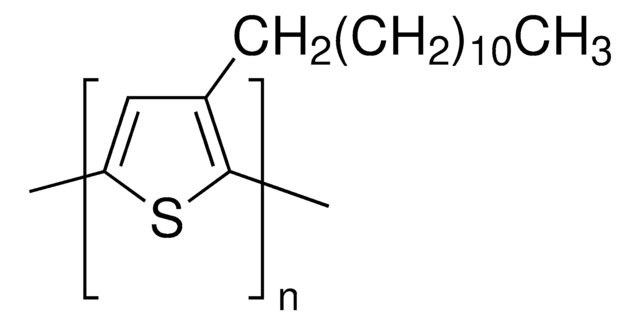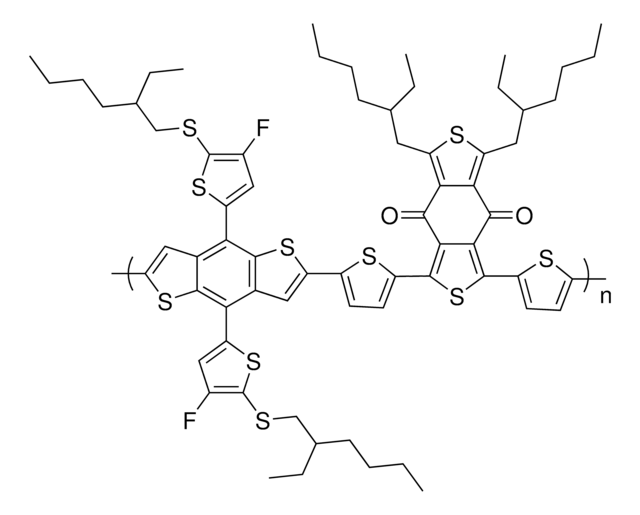745820
Difluoro{3-ethyl-5-[1-(4-ethyl-3,5-dimethyl-2H-pyrrol-2-ylidene-N)ethyl]-2,4-dimethyl-1H-pyrrolato-N}boron
98% (HPLC)
Synonim(y):
1,3,5,7,8-Pentamethyl-2,6-diethylpyrromethene-difluoroborate, 2,6-Diethyl-1,3,5,7,8-pentamethylpyrromethene-boron difluoride, 3-Ethyl-5-[1-(4-ethyl-3,5-dimethyl-2H-pyrrol-2-ylidene)ethyl]-2,4-dimethyl-1H-pyrrole, boron complex, Exciton Pyrromethene 567, P 567, Pyrromethene 567
About This Item
Polecane produkty
Próba
98% (HPLC)
Postać
solid
mp
208-213 °C
fluorescencja
λex 522 nm
ciąg SMILES
CC(C1=C(C)C(CC)=C(C)N1B(F)2F)=C3[N]2=C(C)C(CC)=C3C
InChI
1S/C18H25BF2N2/c1-8-15-10(3)17-12(5)18-11(4)16(9-2)14(7)23(18)19(20,21)22(17)13(15)6/h8-9H2,1-7H3
Klucz InChI
DZSMVBDAUBBZJD-UHFFFAOYSA-N
Opis ogólny
Zastosowanie
Used for solid-state dye laser devices.
Hasło ostrzegawcze
Warning
Zwroty wskazujące rodzaj zagrożenia
Zwroty wskazujące środki ostrożności
Klasyfikacja zagrożeń
Eye Irrit. 2 - Skin Irrit. 2 - STOT SE 3
Organy docelowe
Respiratory system
Kod klasy składowania
11 - Combustible Solids
Klasa zagrożenia wodnego (WGK)
WGK 3
Temperatura zapłonu (°F)
Not applicable
Temperatura zapłonu (°C)
Not applicable
Certyfikaty analizy (CoA)
Poszukaj Certyfikaty analizy (CoA), wpisując numer partii/serii produktów. Numery serii i partii można znaleźć na etykiecie produktu po słowach „seria” lub „partia”.
Masz już ten produkt?
Dokumenty związane z niedawno zakupionymi produktami zostały zamieszczone w Bibliotece dokumentów.
Nasz zespół naukowców ma doświadczenie we wszystkich obszarach badań, w tym w naukach przyrodniczych, materiałoznawstwie, syntezie chemicznej, chromatografii, analityce i wielu innych dziedzinach.
Skontaktuj się z zespołem ds. pomocy technicznej![Difluoro(4-(1,1-dimethylethyl)-2-{1-[4-(1,1-dimethylethyl)-3,5-dimethyl-2H-pyrrol-2-ylidene-N]ethyl}-3,5-dimethyl-1H-pyrrol-2-ylidene-N]ethyl}-3,5-dimethyl-1H-pyrrolato-N)boron 98% (HPLC)](/deepweb/assets/sigmaaldrich/product/structures/207/879/8046aafd-78ca-4fd8-92dc-801de0b6cc53/640/8046aafd-78ca-4fd8-92dc-801de0b6cc53.png)
![Difluoro{2-[(3,5-dimethyl-2H-pyrrol-2-ylidene-N)methyl]-3,5-dimethyl-1H-pyrrolato-N}boron 99% (HPLC)](/deepweb/assets/sigmaaldrich/product/structures/518/861/c19c64be-654e-472e-a069-30ffccb1a8cd/640/c19c64be-654e-472e-a069-30ffccb1a8cd.png)
![Difluoro{2-[1-(3,5-dimethyl-2H-pyrrol-2-ylidene-N)ethyl]-3,5-dimethyl-1H-pyrrolato-N}boron 99% (HPLC)](/deepweb/assets/sigmaaldrich/product/structures/196/394/4c2c0eae-f749-44bf-a37b-84bf0226092e/640/4c2c0eae-f749-44bf-a37b-84bf0226092e.png)







